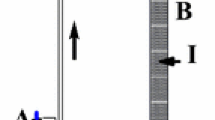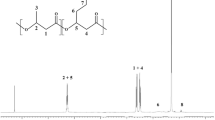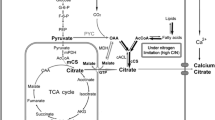Abstract
PHB biosynthesis pathway, consisting of three open reading frames (ORFs) that encode for β-ketothiolase (phaA Cma , 1179 bp), acetoacetyl-CoA reductase (phaB Cma , 738 bp), and PHA synthase (phaC Cma , 1694 bp), of Caldimonas manganoxidans was identified. The functions of PhaA, PhaB, and PhaC were demonstrated by successfully reconstructing PHB biosynthesis pathway of C. manganoxidans in Escherichia coli, where PHB production was confirmed by OD600, gas chromatography, Nile blue stain, and transmission electron microscope (TEM). The protein sequence alignment of PHB synthases revealed that phaC Cma shares at least 60% identity with those of class I PHB synthase. The effects of PhaA, PhaB, and PhaC expression levels on PHB production were investigated. While the overexpression of PhaB is found to be important in recombinant E. coli, performances of PHB production can be quantified as follows: PHB concentration of 16.8 ± 0.6 g/L, yield of 0.28 g/g glucose, content of 74%, productivity of 0.28 g/L/h, and Mw of 1.41 MDa.








Similar content being viewed by others
References
Amara A, Rehm B (2003) Replacement of the catalytic nucleophile cysteine-296 by serine in class II polyhydroxyalkanoate synthase from Pseudomonas aeruginosa-mediated synthesis of a new polyester: identification of catalytic residues. Biochem J 374:413–421
Bertrand J-L, Ramsay B, Ramsay J, Chavarie C (1990) Biosynthesis of poly-β-hydroxyalkanoates from pentoses by Pseudomonas pseudoflava. Appl Environ Microbiol 56(10):3133–3138
Brosius J, Palmer ML, Kennedy PJ, Noller HF (1978) Complete nucleotide sequence of a 16S ribosomal RNA gene from Escherichia coli. Proc Natl Acad Sci U S A 75(10):4801–4805
Chen G-Q, Wu Q (2005) The application of polyhydroxyalkanoates as tissue engineering materials. Biomaterials 26(33):6565–6578. doi:10.1016/j.biomaterials.2005.04.036
Chen W-M, Chang J-S, Chiu C-H, Chang S-C, Chen W-C, Jiang C-M (2005) Caldimonas taiwanensis sp. nov., a amylase producing bacterium isolated from a hot spring. Syst Appl Microbiol 28(5):415–420
Chien C-C, Hong C-C, Soo P-C, Wei Y-H, Chen S-Y, Cheng M-L, Sun Y-M (2010) Functional expression of phaCAB genes from Cupriavidus taiwanensis strain 184 in Escherichia coli for polyhydroxybutyrate production. Appl Biochem Biotechnol 162(8):2355–2364
Guzman LM, Belin D, Carson MJ, Beckwith J (1995) Tight regulation, modulation, and high-level expression by vectors containing the arabinose PBAD promoter. J Bacteriol 177(14):4121–4130. doi:10.1128/jb.177.14.4121-4130.1995
Hiroe A, Tsuge K, Nomura CT, Itaya M, Tsuge T (2012) Rearrangement of gene order in the phaCAB operon leads to effective production of ultrahigh-molecular-weight poly[(R)-3-hydroxybutyrate] in genetically engineered Escherichia coli. Appl Environ Microbiol 78(9):3177–3184. doi:10.1128/aem.07715-11
Horng YT, Chang KC, Chien CC, Wei YH, Sun YM, Soo PC (2010) Enhanced polyhydroxybutyrate (PHB) production via the coexpressed phaCAB and vgb genes controlled by arabinose PBAD promoter in Escherichia coli. Lett Appl Microbiol 50(2):158–167. doi:10.1111/j.1472-765X.2009.02772.x
Hsiao L-J, Lin J-H, Sankatumvong P, Wu T-M, Li S-Y (2016) The feasibility of thermophilic Caldimonas manganoxidans as a platform for efficient PHB production. Appl Biochem Biotechnol 180:852–871. doi:10.1007/s12010-016-2138-0
Jiang Y, Song X, Gong L, Li P, Dai C, Shao W (2008) High poly(β-hydroxybutyrate) production by Pseudomonas fluorescens A2a5 from inexpensive substrates. Enzym Microb Technol 42(2):167–172
Khanna S, Srivastava AK (2005) Statistical media optimization studies for growth and PHB production by Ralstonia eutropha. Process Biochem 40(6):2173–2182
Kim BS, Lee SY, Chang HN (1992) Production of poly-β-hydroxybutyrate by fed-batch culture of recombinant Escherichia coli. Biotechnol Lett 14(9):811–816
Kranz RG, Gabbert KK, Madigan MT (1997) Positive selection systems for discovery of novel polyester biosynthesis genes based on fatty acid detoxification. Appl Environ Microbiol 63(8):3010–3013
Leong YK, Show PL, Ooi CW, Ling TC, Lan JC-W (2014) Current trends in polyhydroxyalkanoates (PHAs) biosynthesis: insights from the recombinant Escherichia coli. J Biotechnol 180:52–65. doi:10.1016/j.jbiotec.2014.03.020
Li Z-J, Cai L, Wu Q, Chen G-Q (2009) Overexpression of NAD kinase in recombinant Escherichia coli harboring the phbCAB operon improves poly(3-hydroxybutyrate) production. Appl Microbiol Biotechnol 83(5):939–947. doi:10.1007/s00253-009-1943-6
Li Y-H, Ou-Yang F-Y, Yang C-H, Li S-Y (2015) The coupling of glycolysis and the Rubisco-based pathway through the non-oxidative pentose phosphate pathway to achieve low carbon dioxide emission fermentation. Bioresour Technol 187:189–197. doi:10.1016/j.biortech.2015.03.090
Lim HN, Lee Y, Hussein R (2011) Fundamental relationship between operon organization and gene expression. Proc Natl Acad Sci U S A 108(26):10626–10631
Liu Y, Huang S, Zhang Y, Xu F (2014) Isolation and characterization of a thermophilic Bacillus shackletonii K5 from a biotrickling filter for the production of polyhydroxybutyrate. J Environ Sci 26(7):1453–1462
McCool GJ, Cannon MC (2001) PhaC and PhaR are required for polyhydroxyalkanoic acid synthase activity in Bacillus megaterium. J Bacteriol 183(14):4235–4243
Pantazaki AA, Tambaka MG, Langlois V, Guerin P, Kyriakidis DA (2003) Polyhydroxyalkanoate (PHA) biosynthesis in Thermus thermophilus: purification and biochemical properties of PHA synthase. Mol Cell Biochem 254(1–2):173–183
Peelman N, Ragaert P, De Meulenaer B, Adons D, Peeters R, Cardon L, Van Impe F, Devlieghere F (2013) Application of bioplastics for food packaging. Trends Food Sci Technol 32(2):128–141
Peoples OP, Sinskey AJ (1989) Poly-beta-hydroxybutyrate (PHB) biosynthesis in Alcaligenes eutrophus H16. Identification and characterization of the PHB polymerase gene (phbC). J Biol Chem 264(26):15298–15303
Philip S, Keshavarz T, Roy I (2007) Polyhydroxyalkanoates: biodegradable polymers with a range of applications. J Chem Technol Biotechnol 82(3):233–247
Rehm B (2003) Polyester synthases: natural catalysts for plastics. Biochem J 376:15–33
Ren Q, de Roo G, van Beilen JB, Zinn M, Kessler B, Witholt B (2005) Poly(3-hydroxyalkanoate) polymerase synthesis and in vitro activity in recombinant Escherichia coli and Pseudomonas putida. Appl Microbiol Biotechnol 69(3):286–292. doi:10.1007/s00253-005-1995-1
Shi H, Nikawa J, Shimizu K (1999) Effect of modifying metabolic network on poly-3-hydroxybutyrate biosynthesis in recombinant Escherichia coli. J Biosci Bioeng 87(5):666–677. doi:10.1016/S1389-1723(99)80132-7
Sim SJ, Snell KD, Hogan SA, Stubbe J, Rha C, Sinskey AJ (1997) PHA synthase activity controls the molecular weight and polydispersity of polyhydroxybutyrate in vivo. Nat Biotechnol 15(1):63–67
Spiekermann P, Rehm BH, Kalscheuer R, Baumeister D, Steinbüchel A (1999) A sensitive, viable-colony staining method using Nile red for direct screening of bacteria that accumulate polyhydroxyalkanoic acids and other lipid storage compounds. Arch Microbiol 171(2):73–80
Takeda M, Koizumi J-I, Yabe K, Adachi K (1998) Thermostable poly(3-hydroxybutyrate) depolymerase of a thermophilic strain of Leptothrix sp. isolated from a hot spring. J Ferment Bioeng 85(4):375–380. doi:10.1016/S0922-338X(98)80080-9
Takeda M, Kamagata Y, Ghiorse WC, Hanada S, Koizumi J-I (2002) Caldimonas manganoxidans gen. nov., sp. nov., a poly (3-hydroxybutyrate)-degrading, manganese-oxidizing thermophile. Int J Syst Evol Microbiol 52(3):895–900
Thakor N, Patel M, Trivedi U, Patel K (2003) Production of poly (β-hydroxybutyrate) by Comamonas testosteroni during growth on naphthalene. World J Microb Biotechnol 19(2):185–189
Tsuge T (2002) Metabolic improvements and use of inexpensive carbon sources in microbial production of polyhydroxyalkanoates. J Biosci Bioeng 94(6):579–584
Tyo KEJ, Fischer CR, Simeon F, Stephanopoulos G (2010) Analysis of polyhydroxybutyrate flux limitations by systematic genetic and metabolic perturbations. Metab Eng 12(3):187–195. doi:10.1016/j.ymben.2009.10.005
Wang F, Lee SY (1997) Production of poly(3-hydroxybutyrate) by fed-batch culture of filamentation-suppressed recombinant Escherichia coli. Appl Environ Microbiol 63(12):4765–4769
Wu H, Chen J, Chen G-Q (2016) Engineering the growth pattern and cell morphology for enhanced PHB production by Escherichia coli. Appl Microbiol Biotechnol 100(23):9907–9916. doi:10.1007/s00253-016-7715-1
Xin J, Zhang Y, Dong J, Song H, Xia C (2013) An experimental study on molecular weight of poly-3-hydroxybutyrate (PHB) accumulated in Methylosinus trichosporium IMV 3011. Afr J Biotechnol 10(36):7078–7087
Xu F, Huang S, Liu Y, Zhang Y, Chen S (2014) Comparative study on the production of poly (3-hydroxybutyrate) by thermophilic Chelatococcus daeguensis TAD1: a good candidate for large-scale production. Appl Microbiol Biotechnol 98(9):3965–3974
Yilmaz M, Soran H, Beyatli Y (2005) Determination of poly-β-hydroxybutyrate (PHB) production by some Bacillus spp. World J Microb Biotechnol 21(4):565–566
Yuan W, Jia Y, Tian J, Snell KD, Müh U, Sinskey AJ, Lambalot RH, Walsh CT, Stubbe J (2001) Class I and III polyhydroxyalkanoate synthases from Ralstonia eutropha and Allochromatium vinosum: characterization and substrate specificity studies. Arch Biochem Biophys 394(1):87–98
Acknowledgements
This work was funded by the Ministry of Science and Technology Taiwan, MOST-103-2221-E-005-072-MY3 and MOST-104-2621-M-005-004-MY3.
Author information
Authors and Affiliations
Corresponding author
Ethics declarations
Conflict of interest
The authors declare that they have no conflict of interest.
Ethical approval
This article does not contain any studies with human participants performed by any of the authors.
Electronic supplementary material
ESM 1
(PDF 1762 kb)
Rights and permissions
About this article
Cite this article
Lin, JH., Lee, MC., Sue, YS. et al. Cloning of phaCAB genes from thermophilic Caldimonas manganoxidans in Escherichia coli for poly(3-hydroxybutyrate) (PHB) production. Appl Microbiol Biotechnol 101, 6419–6430 (2017). https://doi.org/10.1007/s00253-017-8386-2
Received:
Revised:
Accepted:
Published:
Issue Date:
DOI: https://doi.org/10.1007/s00253-017-8386-2




